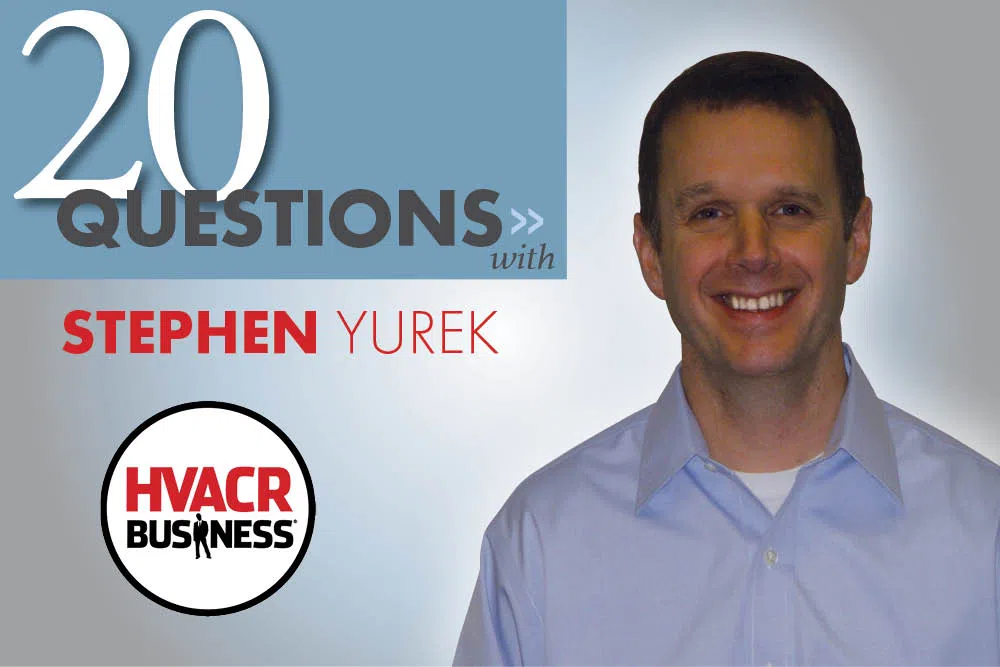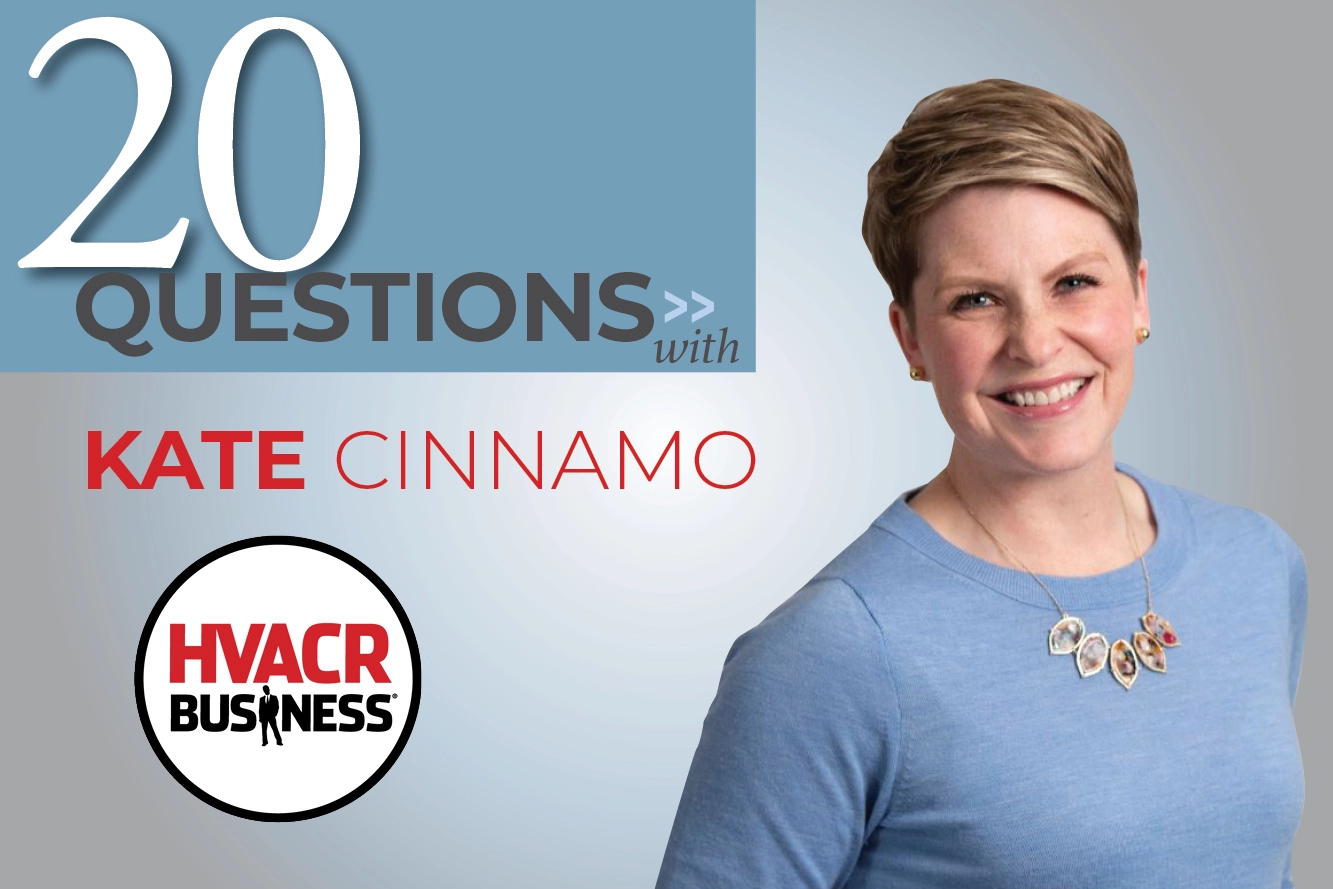At the tail end of 2007. HVACR Business Publisher Terry Tanker visited with Stephen Yurek, president of ARI, at the association's national head-quaters in Arlington, Va. Terry quizzed Stephen on several issues including HVACR regulation, energy bills, and practical jokes.
1. What's the best prank you've ever pulled off?
Francis Dietz, our senior director of public affairs, has a small grocery store hidden in his office. I've kidded him about cleaning up or he'd have rodents in his office. A vendor gave me a stuffed rat during Halloween to help decorate my office. I put it in Francis' cereal box before he came in one morning. His reaction was very entertaining.
2. You can invite three people to dinner fromany era — who are they?
Jesus Christ, Buddha and Mohammed. I'd like to ask them, "What the heck were you thinking?"
3. What is your guilty pleasure?
Getting away to the cabin I built in Northern Minnesota.
4. You win the Mega Lotto — what's the first thing you buy?
A villa in Italy.
5. If you could be a superhero who would it be?
Underdog
6. Before becoming president of the Air-Conditioning Refrigeration Institute (ARI) you were ARI's general counsel for five years. How did you become associated with ARI?
I worked for the National Association of Secondary School Principals as general counsel and chief operating officer. Through work and social circles I was introduced to Woody Sutton (former president of ARI). We became friends and he asked me to join the ARI staff.
7. You're leading ARI through the industry's largest merger ever with the Gas Appliance Manufacturers Association. What has been the most significant challenge?
There have been several. The new association will be called the Air Conditioning, Heating, and Refrigeration Institute (AHRI) and its members will have combined sales of close to $30 billion. The membership is made up of both large and small manufacturers. Our first challenge was to ensure that all voices were heard. Next, was to make sure we had the broadest input on what the new structure and organization would look like, what the culture would be and what services we would provide to the members.
8. Was there a time when you thought the deal wouldn't work?
Mid-year 2007 it seemed like there were many reservations. The concern was that the combined organization would be too large. Some thought influence would be diluted, and individual issues would be drowned out. However, those specific issues were addressed and attitudes changed very rapidly.
9. What was the ARI board meeting like when the merger was on the agenda?
Our board is very large — 52 members — and everyone attended because of the proposed merger. Seeing the interaction among the members was fascinating. Everyone voiced their opinion. Before the meeting several of us thought the vote would be very close but in the end the vote was unanimous to move forward.
10. What are the benefits of the merger?
The industry will have a stronger, broader voice to respond to increasing and more complex energy and environmental issues through greater standards, certification, and advocacy activities. This greater presence will also benefit distributors, contractors, and technicians by giving the industry a broader voice in shaping policies and regulations that impact the HVACR industry.
11. What are the new goals of the organization?
It's too early for specifics. However, in general terms our goals will be to present a unified voice for HVACR manufacturers, promote standard, certification, and advocacy to ensure the vibrant growth of our industry on a global basis.
12. Is more regulation unavoidable in the HVACR industry?
I believe it is unavoidable. However, we can slow it down and help shape it. We also can affect at what level governments will be involved. We can make it less burdensome on manufacturers, distributors and contractors.
13. In the new energy bill — H.R. 6: Renewable Fuels, Consumer Protection, and Energy Efficiency Act of 2007 — California proposed having 16 regional standards for equipment. When do you think regional standards will be part of our industry?
I don't think there is any doubt that the DOE will ultimately have the authority to set regional standards. Because of this, we sat down with the advocates and negotiated a compromise that would shape how regional standards would be adopted and limit the impact on the industry. The compromise would allow one national standard and two others for cooling. For heating it would be one national standard and one other. As part of setting regional standards, the DOE would have to show that there is no economic burden to manufacturers, distributors, contractors and consumers as required by law.
14. How will regional standards impact contractors?
In those regions with a higher standard than the national standard, it will limit the choices for consumers on efficiency making it even more important to sell other features. For all contractors, the largest impact will be the increased price to end users. Contractors will need to become better salesmen and better at explaining some of the inherent costs in the equipment they are selling.
15. Will this be similar to some of the effects we've seen with the move to 13 SEER?
Yes. Since the higher efficiency units are more expensive, the industry has seen consumers elect to repair instead of replace units. In addition, we've graphed room air conditioners in relation to central air conditioners and found that room air conditioner sales have risen at about the same rate as central air conditioner sales have dropped since 2006.
16. What is the opportunity for contractors?
Service and repair. The problem, however, is you can't flip a switch and be in this business. The series of articles your magazine published September through November 2007 is an excellent blueprint on how to start.
17. A large portion of ARI members manufacture commercial equipment. How will they be impacted?
We were successful in removing commercial equipment from the regional standards provisions of the energy bill, so there's no direct impact for those products.
18. What is the most important part of your job?
Maintaining and motivating a high-quality staff — keeping them engaged in the issues and the needs of the industry and of the members.
19. What audience is the most important for you to communicate with?
Regulators in Washington, in the states, and overseas.
20. What is the message?
As an industry we are environmentalists and we have been for the last 50 years. The reason the association was formed was to create standards and certification programs so consumers would have the information they need to make intelligent decisions. Through those programs we've recently increased the energy efficiency of our equipment over 30 percent. On the commercial side, efficiency gains are 35 to 40 percent. We've also worked diligently to create new refrigerants that are better for the environment while simultaneously improving the efficiency of the equipment. And finally, we are willing to work with them on future improvements.






